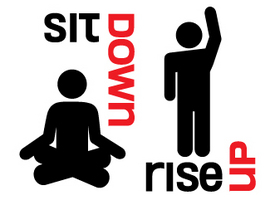by Jerry Kolber
Jerry is a writer and producer of film and TV based in NYC. His site
about how to cook cheap delicious organic meals is at www.ThreeDollarDinner.com.
It’s hard to believe in Judaism and also believe in Christianity, but you can believe in the Bible, and also believe in evolution. Buddhism does not require you to disbelieve anything. You can be Christian and believe in what the Buddha taught. You can believe in the power of the mind to heal, and also believe in the power of surgery. You can believe in ghosts, and still believe the earth rotates the sun every 24 hours. You can be a Jew, and believe in what the Buddha taught.
And once you start to understand the very simple, very basic ideas of what the Buddha taught, you begin to see very clearly that he was really onto something. And that what he was on to was a way to deal with the pervasive sense of dissatisfaction. If your present spiritual practice has you feeling satisfied, and you’re not praying or hoping for an end to your dissatisfaction – you’re truly satisfied, you’re never finding yourself succumbing to fantasy, or retreating into your past – then keep doing what you’re doing!
But if your present practice to understand reality or deal with dissatisfaction – religion, journaling,
running as mediation, gardening, nothing, psychotherapy – leaves you dependent on something outside yourself for relief
of your dissatisfaction, I suggest you give the Buddha’s way a try.
It’s not a cult. It’s not a religion. It’s not even a way of life. It’s
just a way of understanding how things really are.
Because everything else is layers of concept. Perception is another
word for the veil through which we look at reality. And reality, this
present moment, the touch, the sensation, the energy of movement, is
positively exquisite and needs no window dressing. This is the view
that Buddhism offers. Perception is the window through which we look at the world. Buddhist
practice – meditation, study, community – makes you aware of the habit
of confusing the window with the view.
And if you feel so compelled to sit for five minutes today, gently
notice the sensation of the breath entering and leaving your nostril,
notice when you’re drifting into thought or losing focus on the breath.
You WILL fail at not drifting into thought or fantasy – and that’s the
point. That’s why it’s called practice. The cessation of thought is
not the point of Buddhism. The point is the recognition of what thought
is and where it comes from and what control it should and shouldn’t
ought to have over your life.
The Buddha was simply offering an opportunity to use a set of tools to recognize, work with, and step out of the habit of not paying attention
to reality.
Though I have had (and continue to have) many things in my life that might be called “spiritual” or even “religious”, none has been so
deeply effective as my Buddhist meditation practice and study of the Buddha’s teachings at
offering me clarity, insight, and a deepening sense of compassion for
all things in this universe, especially the things I don’t like.
So with our Meditation Marathon approaching this Friday night, I offer you this
reason for why I sit. Our world is filled with an ever increasing
number of ways to throw us off kilter, challenge our basic notions of
goodness, and cause us to wonder “what’s it all about”. There’s a lot
we have to deal with every day, the thousand tiny slings and arrows of
everyday life.
I consider a hallmark of my own evolving practice to be that I am often able to offer
compassion in circumstances in which before I might have habitually
offered aggression. I also find myself able to be more authentically present more frequently – to stand for what I believe in without having to fight for it.

